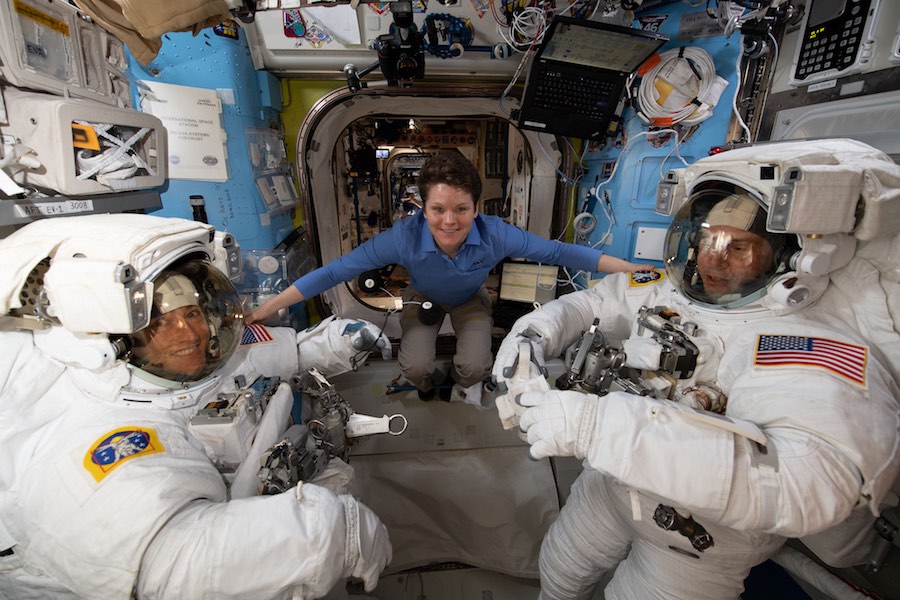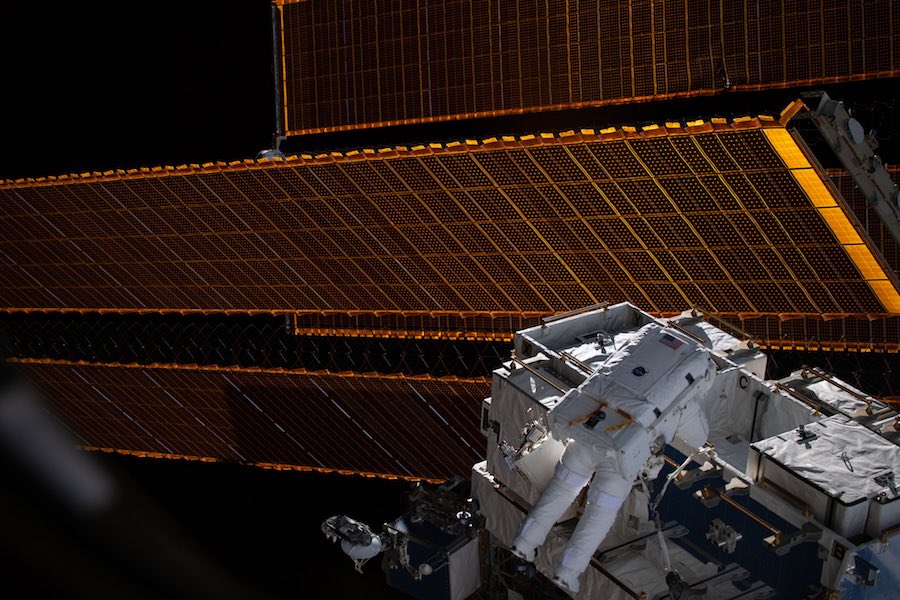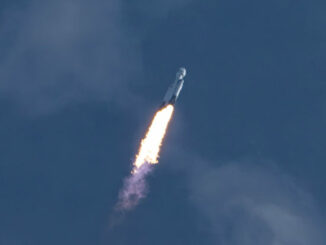EDITOR’S NOTE: Updated March 27 with McClain’s comments.

NASA astronaut Nick Hague will take the place of Anne McClain on a spacewalk Friday outside the International Space Station, teaming up with crewmate Christina Koch to continue a series of battery upgrades on an excursion that would have been the first all-female spacewalk in history.
NASA officials announced the crew change Monday after McClain determined after a spacewalk last Friday that she works better in a spacesuit with a medium-sized hard upper torso. Only one medium hard upper torso, which forms the upper part of the spacesuit, is currently available for a spacewalk on the space station.
During their spacewalk last Friday, McClain and Hague connected three new lithium-ion batteries to the space station’s electrical network. Hague and Koch will install three more batteries and their adapter plates during this Friday’s spacewalk.
“Koch had been scheduled to conduct this spacewalk with astronaut McClain, in what would have been the first all-female spacewalk,” NASA said in a statement Monday. “However, after consulting with McClain and Hague following the first spacewalk, mission managers decided to adjust the assignments, due in part to spacesuit availability on the station.
“McClain learned during her first spacewalk that a medium-size hard upper torso – essentially the shirt of the spacesuit – fits her best,” the statement said. “Because only one medium-size torso can be made ready by Friday, March 29, Koch will wear it.”
Under NASA’s original plan, McClain was slated to wear a large hard upper torso on the upcoming spacewalk. NASA officials said they made the original spacewalk crew assignments to ensure all of the first-time space fliers currently on the space station gained spacewalking experience.
Many astronauts, including McClain, train in multiple spacesuit sizes on the ground. But an astronaut’s individual sizing preferences can change once in space, where prolonged exposure to microgravity can prompt changes in the human body. Generally, a tighter spacesuit enhances an astronaut’s mobility in space.
McClain, a former U.S. Army helicopter pilot, wore the medium hard upper torso last Friday and determined it fit her better than a large hard upper torso.
“This decision was based on my recommendation,” McClain tweeted Wednesday. “Leaders must make tough calls, and I am fortunate to work with a team who trusts my judgement. We must never accept a risk that can instead be mitigated. Safety of the crew and execution of the mission come first.”
NASA’s spacesuits designed for spacewalks, known as Extravehicular Mobility Units, are modular with interchangeable hard upper torsos, arms, legs and helmets. There are currently medium, large and extra large hard upper torsos on the space station. A second medium-sized unit currently on the station would require additional time to prepare for a spacewalk, NASA said, and officials decided to keep the excursion on schedule by changing the crew assignments.
A third spacewalk in the current series is planned for April 8, when McClain will wear the medium-sized hard upper torso and be joined outside the space station by Canadian flight engineer David Saint-Jacques.
McClain became the 13th woman to conduct a spacewalk last Friday, and Koch will be the 14th this Friday.

NASA safety panel raises concerns about aging spacesuits
NASA still uses spacesuits originally developed 40 years ago for the space shuttle program. With in-orbit maintenance by astronauts, and occasional rotations back to Earth aboard commercial supply ships, NASA expects the current lot of suits to remain operational through at least 2024.
The spacesuits designed for spacewalks are more rugged and capable than suits used by astronauts during launch and landing on Russian Soyuz spacecraft and the new SpaceX Crew Dragon and Boeing CST-100 Starliner crew capsules.
NASA originally built 18 life support backpacks for the shuttle-era EMUs, and 11 of them are still certified for spaceflight, according to a 2017 report by NASA’s inspector general examining the agency’s spacesuit projects. Five of the life support units — the most complex part of the suits — were destroyed on missions, including two each on the Challenger and Columbia space shuttle accidents, and one on a SpaceX cargo rocket that failed during launch.
The shuttle-era spacesuits were not intended to remain in space for years at a time, as they now do on the space station. NASA’s inspector general wrote in 2017 that “the spacesuits are operating in a different environment onboard the ISS with longer periods between refurbishment and some maintenance tasks performed on-orbit.
“This has made several of the EMU’s design inadequacies more prominent,” the inspector general wrote, highlighting concerns about water leaks and the limited ability for astronauts to make repairs in space. The agency’s internal watchdog also noted limitations in spacesuit sizing, and the gloves’ propensity to cause hand injuries,
NASA is working on a new spacesuit concept called the Exploration EMU, which could be ready for a demonstration spacewalk outside the space station in 2023. The modernized spacesuit would also be designed for spacewalks on missions venturing farther from Earth, such as the moon’s vicinity.
In the 2017 report on NASA’s spacesuit projects, the agency’s inspector general said NASA has spent nearly $200 million in spacesuit development efforts since 2007.
“Despite this investment, the agency remains years away from having a flight-ready spacesuit capable of replacing the EMU or suitable for EVA use on future exploration missions,” the inspector general wrote at the time.
More recently, members of the independent Aerospace Safety Advisory Panel, or ASAP, discussed the spacesuit development efforts in a meeting March 7.
“EVA suit maintenance remains a challenge and a high priority,” said Richard Williams, a former NASA chief health and medical officer who sits on the safety panel.
Williams said March 7 that NASA is now studying whether to extend the lifetime of the current spacesuits to 2028.
Patricia Sanders, the ASAP chair, urged NASA to prioritize a next-generation spacesuit.
“Rather than continuing to spend resources on extending the life of existing suits, it would be very good if they can get on with, in a more expeditious way, a replacement suit, which we believe would be useful in the long run,” Sanders said.
“They’re doing heroic things to extend the life of the current suit, but we really have to be thinking long term,” said Susan Helms, a former space shuttle and space station astronaut and ASAP member.
Email the author.
Follow Stephen Clark on Twitter: @StephenClark1.



